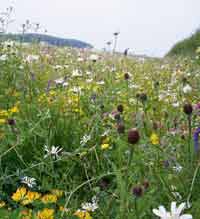Farm4bio project yields first results

Farms must have at least 2% of their land area uncropped to be sure of holding on to key farmland wildlife species.
That’s an early finding from the four-year Farm4bio project (FW, 13 January 2006) where the first-sown covers to encourage biodiversity were established in spring 2007.
Reconciling the need to produce more food while looking after and, if possible, enhancing wildlife is a growing challenge, especially on arable farms dominated by autumn cropping, says project leader Jim Orson of TAG.
Although much useful research was conducted in the SAFFIE experiment and summarised in its Enhancing Arable Biodiversity booklet it didn’t answer the fundamental question of what proportion of farms is required or how covers should be distributed, says Mr Orson. “Our work takes it a step further.”
The £1m Sustainable Arable LINK Farm4bio project is based on 100ha (250-acre) blocks on 24 conventional arable farms (plus four organic ones) in the main southern arable areas. It is examining the biodiversity impact of various treatments applied to 1.5-6ha (4-15-acre) strips or blocks within those farmed areas.
The treatments are:
• Sown flower-rich grass mix, providing nectar for predatory and pollinating insects.
• Sown mix (such as millet and fodder radish) enhancing insect biodiversity and food for birds in summer.
• Sown mix (such as triticale and kale) producing seed for birds over winter.
• Natural regeneration of spring-cultivated land.
 |
|---|
| The Farm4bio project aims to build on the findings of SAFFIE, says Jim Orson |
Recording and analysing the effects, via counts of birds and insects – butterflies, hoverflies and bees – is extremely labour intensive, says Mr Orson. “It’s a huge project overseen by colleagues in BTO, Rothamsted Research and the Game & Wildlife Conservation Trust.”
One initial finding is that while more farmable land out of production generally means more birds, it doesn’t necessarily bring more species.
“Initial analysis suggests that there’s a variation in the response of individual species that appears to be explained by preferences for food source and habitat,” says Mr Orson.
Positive management (as SAFFIE suggested) clearly does enhance biodiversity, the latest work confirms.
“For instance a grass/legume cover hosts far more insects than a grass-only one.
“There’s also some data to suggest that butterflies particularly benefit from the covers when they’re sown in strips rather than blocks.”
By contrast birds seem to prefer large blocks of managed uncropped land to strips along field edges.
But 2008’s wet summer, which would have had dire consequences for pollinating insects, may have restricted some findings, he warns.
The work suggests that the impact of the sown covers depends not only on their extent and distribution, but also on the surrounding landscape.
Much has been found out about the practicality of establishing them on different soils and the biodiversity value of natural regeneration; on heavy soil it has very little, notes Mr Orson.
| Farmer feedback |
|---|
| All participating farmers were visited in February and nearly all said they had agreed to take part to increase biodiversity, with shooting interests a secondary reason, notes Mr Orson. Plenty of conclusions emerged: |

